A massive rescue operation is underway in southern Turkey to save an American explorer who was trapped 3,400 feet from the entrance of the Morca Cave outside the district of Anamur.
Mark Dickey, the 40-year-old American caver, started experiencing gastrointestinal bleeding while with an expedition team in the cave, one of the deepest in Turkey. An international team is moving Dickey out of the cave via a stretcher.
Advertisement
Read live updates on the rescue mission:
Rescue Mission Reaches Final 100 Meters
Mark Dickey is nearing the cave exit.The Turkish Caving Federation announced Monday that rescue crews have only 100 meters left to escort Dickey toward the mouth of the cave, and that he would likely be "out tonight."
Rescue Mission Likely To Be Completed By Tomorrow: Turkish Caving Federation
The Turkish Caving Federation said the operation to rescue Dickey is entering its final stage and will hopefully be completed by tomorrow at the latest.
Rescuers will resume their mission to free Dickey from -180 meters after he takes some time to rest.
"If everything goes well, it is aimed to rescue Mark completely by tonight or tomorrow," the group wrote on X, the platform formerly known as Twitter.
Rescuers will resume their mission to free Dickey from -180 meters after he takes some time to rest.
"If everything goes well, it is aimed to rescue Mark completely by tonight or tomorrow," the group wrote on X, the platform formerly known as Twitter.

European Cave Rescue Association
Rescue Operation Reaches Its Next Stop
Dickey's rescue team has brought him to the -500m camp, the European Cave Rescue Association said Sunday evening local time. His status is stable, and the rescue team members are in good physical condition.
The group shared some photos of the site here.
The group shared some photos of the site here.
On To The Next Camp
According to the Turkish Caving Federation, Dickey was delivered to the campsite at -700 meters at 3:24 a.m. local time. Dickey rested and received “the necessary treatments” at the site before continuing the journey.
At 9:55 a.m. local time, rescuers began the second stage of the mission by transporting Dickey on a stretcher to the next camp. The second camp is at -500 meters, meaning Dickey and the rescue team need to travel about 200 meters — or about 656 feet — to reach it.
At 9:55 a.m. local time, rescuers began the second stage of the mission by transporting Dickey on a stretcher to the next camp. The second camp is at -500 meters, meaning Dickey and the rescue team need to travel about 200 meters — or about 656 feet — to reach it.
Dickey Is Close To The Campsite
The rescue team has been working throughout the day to transport Dickey, and as of this evening, Dickey has reached -700 meters — the goal for the first stage of the mission.
But the climber has yet to reach the campsite, which is located at that depth. According to the Turkish Caving Federation, there is still a horizontal and narrow passage between him and the campsite.
Over the past 10 hours, the rescue team has helped transport Dickey a total of 300 meters, or 984 feet.
But the climber has yet to reach the campsite, which is located at that depth. According to the Turkish Caving Federation, there is still a horizontal and narrow passage between him and the campsite.
Over the past 10 hours, the rescue team has helped transport Dickey a total of 300 meters, or 984 feet.
Rescue Operation Has Begun
The mission to rescue Dickey is underway, The Associated Press reported, citing a Turkish disaster management agency.
Previously, rescuers were waiting for the OK from doctors to attempt to move the man, who began suffering from severe gastrointestinal pain while more than 3,000 feet below the entrance of Turkey's Morca Cave.
Previously, rescuers were waiting for the OK from doctors to attempt to move the man, who began suffering from severe gastrointestinal pain while more than 3,000 feet below the entrance of Turkey's Morca Cave.
Cave Expansion And Texting System Are Underway
Cavers from the eight countries working to extract Dickey have begun using explosives to widen some narrow passages, allowing them to accommodate a stretcher, according to a New York Times report Friday. They’ve also been installing a wireless texting system called Cave-Link as a backup to the phone line running down the cave.
“This is one of the most difficult cave rescue operations in the world,” Recep Salci, the head of rescue efforts for Turkey’s national disaster relief organization, told the Times.
“This is one of the most difficult cave rescue operations in the world,” Recep Salci, the head of rescue efforts for Turkey’s national disaster relief organization, told the Times.
Rescue Efforts Could Begin As Soon As Saturday
The mission to rescue Mark Dickey could begin as soon as Saturday, as a coalition of more than 200 rescue workers makes final preparations for the monumental effort, Turkish rescue officials said.
“With this good news, with doctors saying you can take him out now, slowly, tomorrow or the next day at the latest, we will start his rescue,” Recep Şalcı, head of search and rescue for Turkey’s Disaster and Emergency Management Authority, told NBC News.
“With this good news, with doctors saying you can take him out now, slowly, tomorrow or the next day at the latest, we will start his rescue,” Recep Şalcı, head of search and rescue for Turkey’s Disaster and Emergency Management Authority, told NBC News.
Rescue Teams Prepare To Help Free Dickey
The European Cave Rescue Association said rescuers are adding more ropes and fixings and installing an additional communications system to facilitate Dickey's way out.
The cave has been divided into seven parts. A different rescue team will be responsible for each of those segments, the group wrote in an update posted on its website at 7:30 a.m. ET.
"The doctors are working to further improve the patient’s [health] so that the difficult transport to the surface can begin soon without further complications," the group added.
The cave has been divided into seven parts. A different rescue team will be responsible for each of those segments, the group wrote in an update posted on its website at 7:30 a.m. ET.
"The doctors are working to further improve the patient’s [health] so that the difficult transport to the surface can begin soon without further complications," the group added.
Rescue Mission Could Take Up To 4 Days: Official
Cenk Yildiz, a regional official from Turkey’s disaster relief agency, told the IHA news agency the rescue mission for Mark Dickey could take up to four days.
"The doctors we sent down were very successful in treating him," Yildiz said. "We are now in a position to evacuate him."
Yildiz, though, added the operation remains challenging.
"It would take a (healthy) person 16 hours to come out," Yildiz explained. "This operation will last at least three or four days. Our priority is health. Our aim is to conclude this operation without anyone coming under any danger."
"The doctors we sent down were very successful in treating him," Yildiz said. "We are now in a position to evacuate him."
Yildiz, though, added the operation remains challenging.
"It would take a (healthy) person 16 hours to come out," Yildiz explained. "This operation will last at least three or four days. Our priority is health. Our aim is to conclude this operation without anyone coming under any danger."
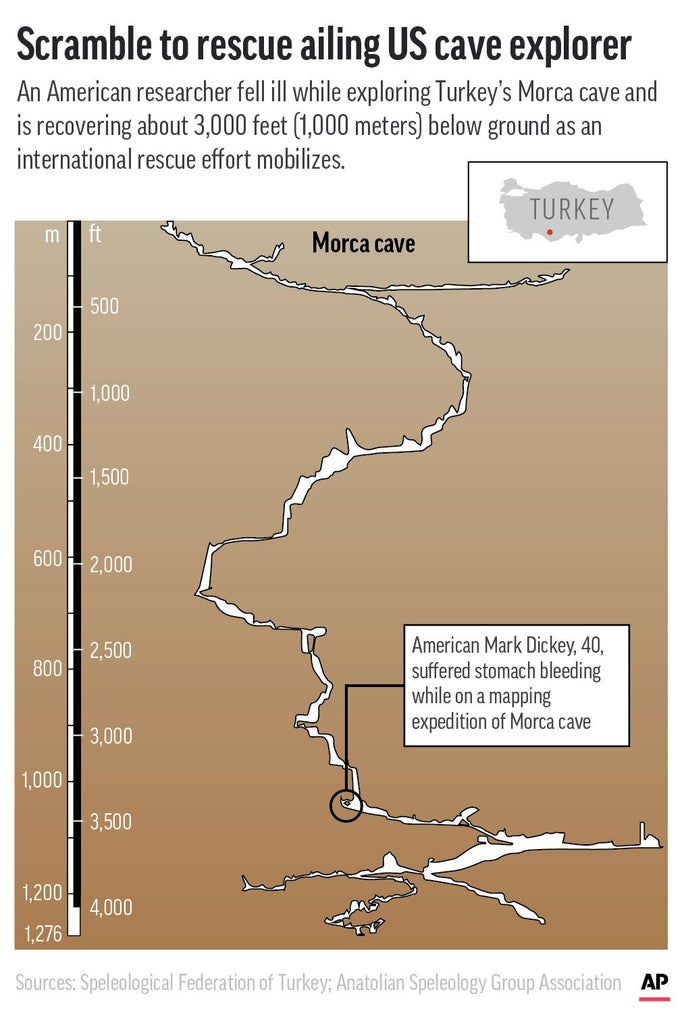
AP Graphic
Graphic Shows Complexity Needed For Rescue Effort
Dickey is trapped about 3,400 feet from the entrance to the cave, deep below ground. Any recovery effort will be enormously complex, as the passage is too narrow at points for a stretcher to pass through, The Associated Press notes.
Yusuf Ogrenecek, an expert with the Speleological Federation of Turkey, told the wire service cave rescues are labor intensive, requiring people to work in mud, water and at low temperatures for long periods of time.
Yusuf Ogrenecek, an expert with the Speleological Federation of Turkey, told the wire service cave rescues are labor intensive, requiring people to work in mud, water and at low temperatures for long periods of time.
Key Things To Know
- American explorer Mark Dickey, a seasoned caver, was on a trip to explore Turkey’s deep Morca Cave when he developed severe gastrointestinal pain and bleeding while thousands of feet underground, preventing him from making what would typically be a 15-hour journey to the surface.
- Once authorities were alerted, one of several international rescue groups made its way to the 40-year-old caver and administered livesaving medical care. His condition has improved but not enough for him to climb out without great assistance, and likely the help of a stretcher.
- Rescuers are developing a plan to extract Dickey and hope to begin the mission Saturday or Sunday. In order to navigate a stretcher through the narrow passageways, crews are widening parts of the cave and addressing the risk of falling rocks. Extraction could take as long as 15 days, rescuers warn.
- Communication between the trapped caver and the outside world takes about five to seven hours, with runners going between his location and a phone line just below the cave’s entrance to share updates on his well-being.
- In a video message from inside the cave, Dickey remarked: “I do know that the quick response of the Turkish government to get the medical supplies that I need, in my opinion, saved my life. I was very close to the edge.” He thanked the “really tight-knit” international caving community.
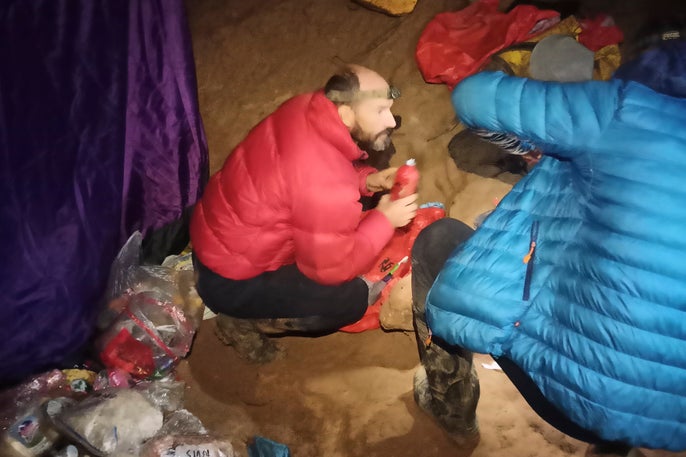
AP Images
The Current Rescue Plans
Plans are underway for rescue crews to extract Dickey this weekend. Marton Kovacs of the Hungarian Cave Rescue Service, which was the first to arrive at Dickey’s location, told The Associated Press that teams are working to widen some passages enough for a stretcher to pass and address the risk of falling rocks.
Rescue crews are hoping to begin Dickey’s extraction Saturday or Sunday and expect it to take several days, possibly weeks.
"If he has to be carried in a stretcher. It will most likely take 10-15 days, maybe more,” Dr. Yaman Ozakin, a spokesman for the Turkish Caving Federation, told The BBC.
Rescue teams from different countries are responsible for seven different sections of the cave, Cave Rescue Bulgaria explained in a Facebook update, adding that they may be able to forgo a stretcher in the tightest spots given that Dickey’s condition has improved.
An Italian rescuer who oversaw a 2014 cave rescue in Germany has been put in charge of the overall plan, the Bulgarian team said.
Rescue crews are hoping to begin Dickey’s extraction Saturday or Sunday and expect it to take several days, possibly weeks.
"If he has to be carried in a stretcher. It will most likely take 10-15 days, maybe more,” Dr. Yaman Ozakin, a spokesman for the Turkish Caving Federation, told The BBC.
Rescue teams from different countries are responsible for seven different sections of the cave, Cave Rescue Bulgaria explained in a Facebook update, adding that they may be able to forgo a stretcher in the tightest spots given that Dickey’s condition has improved.
An Italian rescuer who oversaw a 2014 cave rescue in Germany has been put in charge of the overall plan, the Bulgarian team said.
A Timeline Of The Cave Rescue So Far
Saturday, Sept. 2: The European Cave Rescue Association receives a call that a member of an expedition team has fallen ill in the cave with severe gastric pain. Dickey is at a camp 3,400 feet from the entrance.
Sunday, Sept. 3: A team from the Hungarian Cave Rescue Service, including a doctor, travel to the cave and descend, reaching Dickey. They set up an intensive medical care tent.
Monday, Sept. 4: Other rescue teams from Hungary and Bulgaria arrive. A total of 17 people are on-site to provide aid.
Tuesday, Sept. 5: Recovery planning is underway to tackle the logistical issues of removing Dickey from deep underground. It would take around 15 hours for an experienced caver to reach the surface in ideal conditions.
Wednesday, Sept. 6: Other teams from Italy, Croatia and Poland are on their way to the site.
Thursday, Sept. 7: Dickey releases a video thanking Turkish first responders and the caving community. “I do know that the quick response of the Turkish government to get the medical supplies that I need, in my opinion, saved my life. I was very close to the edge.”
Sunday, Sept. 3: A team from the Hungarian Cave Rescue Service, including a doctor, travel to the cave and descend, reaching Dickey. They set up an intensive medical care tent.
Monday, Sept. 4: Other rescue teams from Hungary and Bulgaria arrive. A total of 17 people are on-site to provide aid.
Tuesday, Sept. 5: Recovery planning is underway to tackle the logistical issues of removing Dickey from deep underground. It would take around 15 hours for an experienced caver to reach the surface in ideal conditions.
Wednesday, Sept. 6: Other teams from Italy, Croatia and Poland are on their way to the site.
Thursday, Sept. 7: Dickey releases a video thanking Turkish first responders and the caving community. “I do know that the quick response of the Turkish government to get the medical supplies that I need, in my opinion, saved my life. I was very close to the edge.”
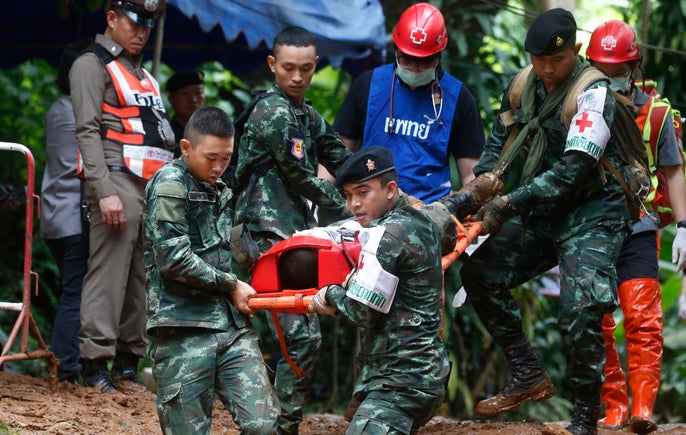
Associated Press
There Have Been Several Previous Successful Cave Rescues
As rescue efforts to save Mark Dickey continue, there are reasons to remain optimistic, including that in recent years there have been several successful cave rescues.
In a similar situation to Dickey's, an injured explorer was trapped in Germany’s deepest cave system in 2014. Johann Westhauser, 52, injured his head in a rock fall and was unable to leave the cave on his own. Hundreds of rescue workers were on hand to help in the rescue operation, and after 12 days Westhauser was safely returned to the surface.
In perhaps the most well-known cave rescue in recent years, a junior soccer team was trapped in a cave in Thailand for two weeks in 2018. The 12 boys and their coach were stuck in the Tham Luang Cave after heavy rains trapped them. The rescue effort took several days, and officials said the team’s coach was among “the weakest in the group” because he gave up his share of food and water to the boys.
In 2004, six British soldiers were trapped in the Alpazat caverns in Puebla, Mexico, after heavy rain flooded the cave system. Their rescue eight days later set off rumors about whether the soldiers had gone into the cave in search of uranium deposits.
And in 1991, more than 200 people mobilized to rescue Emily Mobley, who got trapped in New Mexico’s Lechuguilla Cave after she broke her leg. Thankfully, Mobley had been part of a five-person team surveying the cave and was successfully rescued the following day.
In a similar situation to Dickey's, an injured explorer was trapped in Germany’s deepest cave system in 2014. Johann Westhauser, 52, injured his head in a rock fall and was unable to leave the cave on his own. Hundreds of rescue workers were on hand to help in the rescue operation, and after 12 days Westhauser was safely returned to the surface.
In perhaps the most well-known cave rescue in recent years, a junior soccer team was trapped in a cave in Thailand for two weeks in 2018. The 12 boys and their coach were stuck in the Tham Luang Cave after heavy rains trapped them. The rescue effort took several days, and officials said the team’s coach was among “the weakest in the group” because he gave up his share of food and water to the boys.
In 2004, six British soldiers were trapped in the Alpazat caverns in Puebla, Mexico, after heavy rain flooded the cave system. Their rescue eight days later set off rumors about whether the soldiers had gone into the cave in search of uranium deposits.
And in 1991, more than 200 people mobilized to rescue Emily Mobley, who got trapped in New Mexico’s Lechuguilla Cave after she broke her leg. Thankfully, Mobley had been part of a five-person team surveying the cave and was successfully rescued the following day.
Caver's Parents: 'Our Prayers Are Being Answered'
Dickey's parents, Andrew and Deborah Ann Dickey, said their son was receiving medical attention.
“Mark is strong, but he needed his fellow cavers, including, of course, the doctors, to allow a devastatingly scary situation to turn positive,” they said in a statement, according to the New York Daily News. “Our prayers are being answered and we cannot express how much that means, and will always mean, to us.”
Dickey is one member of a 14-person expedition mapping the Morca cave system.
“Mark is strong, but he needed his fellow cavers, including, of course, the doctors, to allow a devastatingly scary situation to turn positive,” they said in a statement, according to the New York Daily News. “Our prayers are being answered and we cannot express how much that means, and will always mean, to us.”
Dickey is one member of a 14-person expedition mapping the Morca cave system.
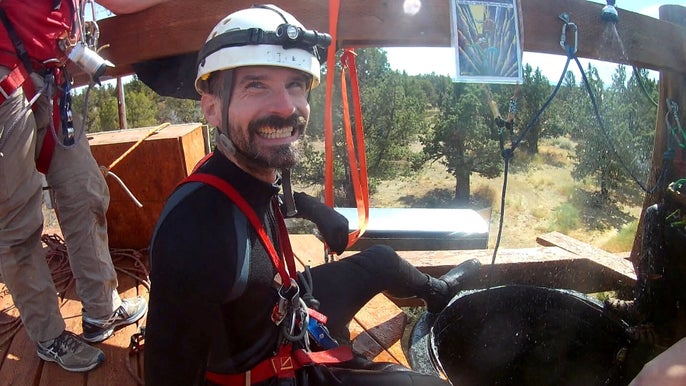
Reuters
Who Is Mark Dickey?
Dickey, a 40-year-old cave researcher and explorer from New Jersey, is an instructor with the U.S.-based National Cave Rescue Commission who also serves as the organization’s international exchange program coordinator. The volunteer-based group was “developed primarily to train and track cave rescue resources throughout the United States.”
The European Cave Rescue Association describes Dickey as a member of its medical committee and “a highly trained caver and a cave rescuer himself” who is well known in the speleological community across the globe.
He’s engaged to Jessica Van Ord, who was also part of the expedition into the Morca cave. She stayed with him while he first began experiencing gastrointestinal issues and bleeding while inside the cave, but she began climbing out when his condition improved. She’s expected to resurface at some point Thursday.
The European Cave Rescue Association describes Dickey as a member of its medical committee and “a highly trained caver and a cave rescuer himself” who is well known in the speleological community across the globe.
He’s engaged to Jessica Van Ord, who was also part of the expedition into the Morca cave. She stayed with him while he first began experiencing gastrointestinal issues and bleeding while inside the cave, but she began climbing out when his condition improved. She’s expected to resurface at some point Thursday.
Cave Communications
Communication with Mark Dickey is an expedition in itself.
Dickey is trapped nearly 3,000 feet below the cave entrance after becoming ill during a journey with other researchers. Since rescuers got word that Dickey had become trapped, communication with him and the outside world has taken between five to seven hours, according to The Associated Press.
Runners head deep into the cave to speak with Dickey before returning to a telephone line set up just below the cave’s entrance to share status updates.
In one instance, a video of Dickey from inside the cave was shared with media outlets.
“The caving world is a really tight-knit group and it’s amazing to see how many people have responded on the surface,” Dickey said in the video.
Dickey is trapped nearly 3,000 feet below the cave entrance after becoming ill during a journey with other researchers. Since rescuers got word that Dickey had become trapped, communication with him and the outside world has taken between five to seven hours, according to The Associated Press.
Runners head deep into the cave to speak with Dickey before returning to a telephone line set up just below the cave’s entrance to share status updates.
In one instance, a video of Dickey from inside the cave was shared with media outlets.
“The caving world is a really tight-knit group and it’s amazing to see how many people have responded on the surface,” Dickey said in the video.
Trapped Caver Sends Video Message Thanking Rescuers
In a video message from inside the cave that American explorer Mark Dickey is trapped in, he thanked Turkish first responders and the caving community.
“The caving world is a really tight-knit group and it’s amazing to see how many people have responded on the surface,” Dickey said in the video. “I do know that the quick response of the Turkish government to get the medical supplies that I need, in my opinion, saved my life. I was very close to the edge.”
Dickey, who experienced gastrointestinal bleeding while more than half a mile deep in the cave, was able to stand and move around in the video. Dickey clarified that he is not “healed on the inside” however, and will still need help to escape the cave.
“The caving world is a really tight-knit group and it’s amazing to see how many people have responded on the surface,” Dickey said in the video. “I do know that the quick response of the Turkish government to get the medical supplies that I need, in my opinion, saved my life. I was very close to the edge.”
Dickey, who experienced gastrointestinal bleeding while more than half a mile deep in the cave, was able to stand and move around in the video. Dickey clarified that he is not “healed on the inside” however, and will still need help to escape the cave.
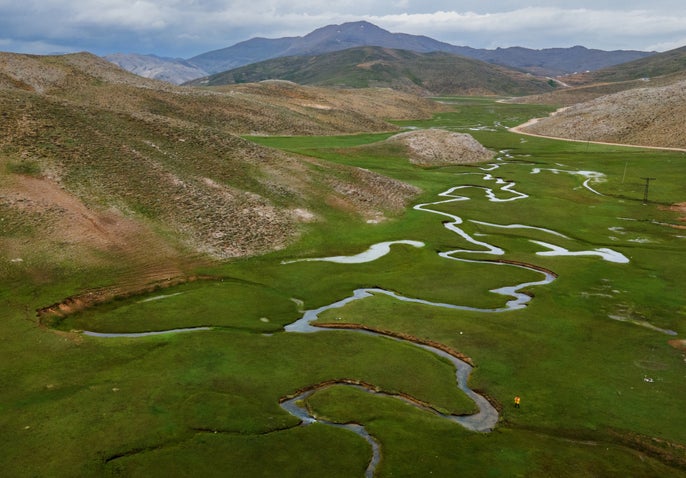
Getty Images
About The Cave Where Dickey Is Stranded
Located in southern Turkey's Taurus Mountains (pictured above), Morca sinkhole is the third-deepest cave in the country with a depth of more than 4,100 feet, according to the Turkish Caving Federation. The cave is very narrow, which will make removing Dickey on a stretcher a complicated task.
"The cave is mostly vertical, but it doesn’t go straight down,” Dickey’s friend and fellow caver Carl Heitmeyer told NBC News.
"There’s water in-feeding from two points near the top of the cave and some of the passages are filled with water, and there are tight squeezes and corkscrews where you have to turn your body in [a] certain way," he continued.
The cave is frequently visited by scientists studying calcite formations in the caves, collecting biological samples from its water pools and doing other research.
"The cave is mostly vertical, but it doesn’t go straight down,” Dickey’s friend and fellow caver Carl Heitmeyer told NBC News.
"There’s water in-feeding from two points near the top of the cave and some of the passages are filled with water, and there are tight squeezes and corkscrews where you have to turn your body in [a] certain way," he continued.
The cave is frequently visited by scientists studying calcite formations in the caves, collecting biological samples from its water pools and doing other research.
Rescue Could Take Days
Due to many difficult factors, including Dickey's condition, the depth at which he fell ill and the cave's narrowness, the rescue could take several days.
"It’s still expected to take quite a few days to get him all the way out of the cave, as it’s such a difficult and technical cave and he is so far deep in it right now," Gretchen Baker of the National Cave Rescue Commission told NBC News.
CBS reported that parts of the cave were being widened to accommodate a stretcher.
"It’s still expected to take quite a few days to get him all the way out of the cave, as it’s such a difficult and technical cave and he is so far deep in it right now," Gretchen Baker of the National Cave Rescue Commission told NBC News.
CBS reported that parts of the cave were being widened to accommodate a stretcher.
Massive Team Helping With Rescue
According to Turkey's caving federation, more than 150 people are aiding the rescue mission. The team includes individuals from Turkey, Poland, Hungary, Bulgaria, Croatia and Italy.











